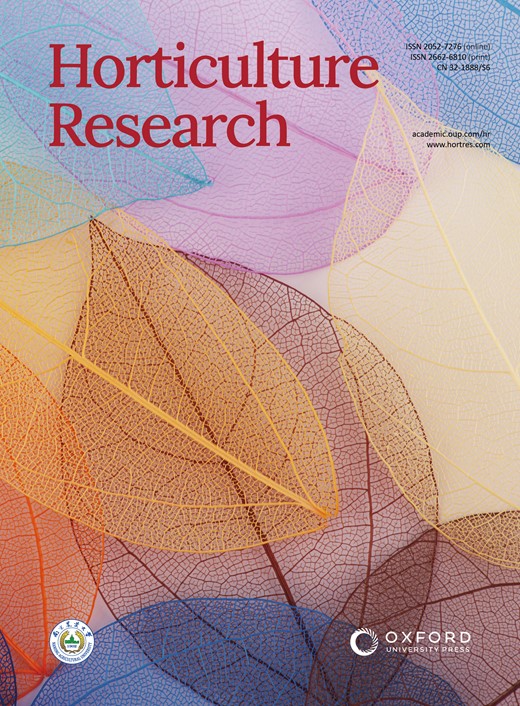探索全多倍体荠菜的遗传多样性、种群结构和亚基因组差异:对未来育种和研究的影响
IF 8.7
1区 农林科学
Q1 Agricultural and Biological Sciences
引用次数: 0
摘要
荠菜(Camelina sativa)是一种异源六倍体物种,是一种新兴的航空生物燃料作物,近几十年来一直是人们重新关注的焦点。为了指导未来的育种和作物改良工作,社会各界需要更深入地了解在异源多倍体物种中经常出现的亚基因组优势,同时了解育种计划中材料的遗传多样性和种群结构。我们利用新的基因组对荠菜多样性面板进行了群体遗传分析,以估计核苷酸多样性和群体结构,并分析了不同器官间亚基因组表达优势的模式。我们的分析证实,荠菜的遗传多样性相对较低,并表明与其他两个亚基因组相比,SG3 亚基因组的遗传多样性要低得多。尽管遗传多样性较低,但我们的分析发现了 13 个不同的亚群,包括两个不同的野生种群和其他可能代表现有育种种群中创始者的种群。长非编码 RNA 在(a)生物胁迫耐受性中发挥着重要作用,在分析长非编码 RNA 的亚基因组组成时,我们发现与其他亚基因组相比,SG3 亚基因组含有更多的 lincRNA。同样,转录组分析表明,SG3 的表达优势并不像以前报道的那样强,而且可能并不普遍存在于所有器官类型中。从整体分析来看,SG3 仅在花朵、花蕾和果实器官中表达量明显较高,鉴于作物产量与这些器官有关,这是一个重要发现。总之,这些结果对指导未来的荠菜育种工作很有价值。本文章由计算机程序翻译,如有差异,请以英文原文为准。
Exploring genetic diversity, population structure, and subgenome differences in the allopolyploid Camelina sativa: implications for future breeding and research studies
Camelina (Camelina sativa), an allohexaploid species, is an emerging aviation biofuel crop that has been the focus of resurgent interest in recent decades. To guide future breeding and crop improvement efforts, the community requires a deeper comprehension of subgenome dominance, often noted in allopolyploid species, alongside and understanding of the genetic diversity and population structure of material present within breeding programs. We conducted population genetic analyses of a C. sativa diversity panel, leveraging a new genome, to estimate nucleotide diversity and population structure, and analyzed for patterns of subgenome expression dominance among different organs. Our analyses confirm that C. sativa has relatively low genetic diversity, and show that the SG3 subgenome has substantially lower genetic diversity compared to the other two subgenomes. Despite the low genetic diversity, our analyses identified thirteen distinct subpopulations including two distinct wild populations and others putatively representing founders in existing breeding populations. When analyzing for subgenome composition of long non-coding RNAs, which are known to play important roles in (a)biotic stress tolerance, we found that the SG3 subgenome contained significantly more lincRNAs compared to other subgenomes. Similarly, transcriptome analyses revealed that expression dominance of SG3 is not as strong as previously reported, and may not be universal across all organ-types. From a global analysis, SG3 was only significant higher expressed in flower, flower bud, and fruit organs, which is an important discovery given that the crop yield is associated with these organs. Collectively, these results will be valuable for guiding future breeding efforts in camelina.
求助全文
通过发布文献求助,成功后即可免费获取论文全文。
去求助
来源期刊

Horticulture Research
Biochemistry, Genetics and Molecular Biology-Biochemistry
CiteScore
11.20
自引率
6.90%
发文量
367
审稿时长
20 weeks
期刊介绍:
Horticulture Research, an open access journal affiliated with Nanjing Agricultural University, has achieved the prestigious ranking of number one in the Horticulture category of the Journal Citation Reports ™ from Clarivate, 2022. As a leading publication in the field, the journal is dedicated to disseminating original research articles, comprehensive reviews, insightful perspectives, thought-provoking comments, and valuable correspondence articles and letters to the editor. Its scope encompasses all vital aspects of horticultural plants and disciplines, such as biotechnology, breeding, cellular and molecular biology, evolution, genetics, inter-species interactions, physiology, and the origination and domestication of crops.
 求助内容:
求助内容: 应助结果提醒方式:
应助结果提醒方式:


